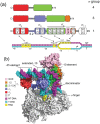Bacterial Sigma Factors and Anti-Sigma Factors: Structure, Function and Distribution
- PMID: 26131973
- PMCID: PMC4598750
- DOI: 10.3390/biom5031245
Bacterial Sigma Factors and Anti-Sigma Factors: Structure, Function and Distribution
Abstract
Sigma factors are multi-domain subunits of bacterial RNA polymerase (RNAP) that play critical roles in transcription initiation, including the recognition and opening of promoters as well as the initial steps in RNA synthesis. This review focuses on the structure and function of the major sigma-70 class that includes the housekeeping sigma factor (Group 1) that directs the bulk of transcription during active growth, and structurally-related alternative sigma factors (Groups 2-4) that control a wide variety of adaptive responses such as morphological development and the management of stress. A recurring theme in sigma factor control is their sequestration by anti-sigma factors that occlude their RNAP-binding determinants. Sigma factors are then released through a wide variety of mechanisms, often involving branched signal transduction pathways that allow the integration of distinct signals. Three major strategies for sigma release are discussed: regulated proteolysis, partner-switching, and direct sensing by the anti-sigma factor.
Keywords: RIP; RNA polymerase; anti-sigma; extracytoplasmic; partner-switching; sigma; signal transduction; stress; transcription.
Figures




References
Publication types
MeSH terms
Substances
Grants and funding
LinkOut - more resources
Full Text Sources
Other Literature Sources
Miscellaneous

